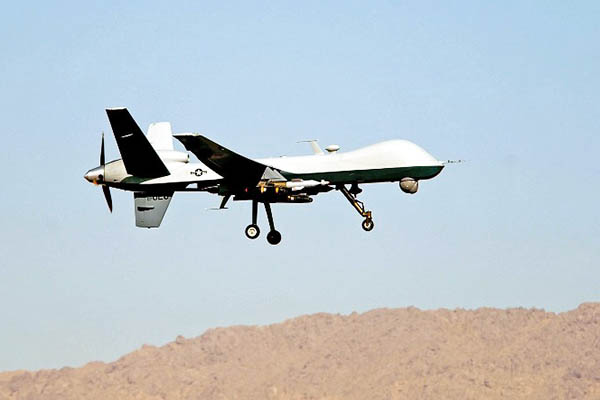
James Lee Harper Jr.-USAF—AFP
New documentary follows three whistleblowers who decided to speak out due to guilt over deaths of civilians in drone strikes.
The convoy had stopped for prayers in a Taliban stronghold in southern Afghanistan when the Hellfire missiles came out of a clear blue sky, incinerating vehicles and liquidating 23 unarmed civilians. The February 2010 attack, involving U.S. drone operators who were later described as “inaccurate and unprofessional” in a military investigation, fueled the growing outcry over America’s rapidly expanding drone wars.
The personnel who mistook the travelers for insurgents had been analyzing Predator drone footage from Creech Air Force Base in Nevada, directing a remote-control massacre thousands of miles from the victims. They reported that they could see only military-age men in the three vehicles but several of the dead and wounded turned out to be women in brightly colored civilian clothing and their children.
The incident, and what it reveals about America’s secretive drone program, is the subject of National Bird, a disturbing documentary released in U.S. theaters on Nov. 11. The feature-length investigation follows three whistleblowers who, plagued by guilt over participating in the killing of faceless people in foreign countries, decide to speak out.
“I knew I had to do something because I knew what was happening was wrong and it was growing exponentially out of control,” said Lisa Ling, a former drone system technical sergeant in California. In the documentary Ling shares a letter of commendation she received for having helped to identify 121,000 insurgent targets over a two-year period.
She asks that viewers “do the math” to estimate how many deaths there have been since America declared war on the Taliban after the September 11, 2001 terror attacks in the U.S.
The problem with drone warfare, says Ling, is partly the unreliability of the fuzzy images analysts use to make life and death decisions, although the technology will inevitably improve. A bigger issue however is the detachment of the drone operators—geographically an emotionally—from the faraway consequences of their decisions.
The White House puts the number of non-combatants killed by drones in Pakistan, Yemen, Somalia and Libya from 2009-15 at up to 116, although the Bureau of Investigative Journalists claims the figure is at least six times that.
President Barack Obama has defended the use of the technology, declaring in 2013 that strikes were only carried out when there was “near certainty” that the target was present. “At that time there wasn’t a lot of information at all,” said New York-based filmmaker Sonia Kennebeck, who was just starting research for National Bird. “People were commenting about the drone war but you couldn’t really get access to people who worked in the program.”
She managed to track down Ling, Heather Linebaugh, a former drone operative suffering from post-traumatic stress disorder, and “Dan,” a civilian intelligence analyst who was the target of an Espionage Act investigation.
Kennebeck traveled with Ling to Afghanistan to meet the innocent victims of the 2010 attack, adults and children who had lost loved ones, not to mention limbs.
The aim, she says, was to start a debate that had been utterly absent from the public conversation, about whether people wanted drone warfare waged on their behalf and—if they did—how to regulate it. “The question is how precise and surgical is it really to drop a bomb on a house? Do you really know with 100 percent certainty who is inside and who you are killing?” she asks.
According to U.S. public policy think tank New America, 86 countries have some drone technology. Earlier this year Nigeria became the eighth country to have used armed drones in combat. The Lebanese Islamist militant group Hezbollah has also used them.
“This is our taxpayer money. We are paying to have this happen so at least we should say we are okay with this, or not okay with it,” said U.S.-based Ines Hofmann Kanna, who produced National Bird. “We’re not even discussing it, really. That’s a problem.”
The 92-minute National Bird is being released as Obama prepares to make way for a successor who will be in a position to re-evaluate the moral case for drones, and their efficacy in warfare. “I’d like to see whoever comes into office watch this film and understand that, from the ground, drones are terror,” says Ling.
“If you’re walking through a garden with your grandmother and you don’t know within the next 10 seconds whether you’re going to see your grandmother in pieces, that’s called terror.”
